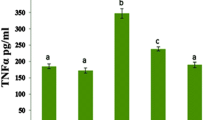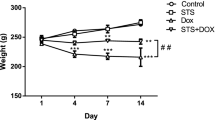Abstract
Doxorubicin (DOX) is a broad-spectrum anthracycline antibiotic that has cardiotoxicity as a major side effect. One mechanism of this toxicity is believed to involve the reactive oxygen radical species (ROS); these agents likely account for the pathophysiology of DOX-induced cardiomyopathy. Aminoguanidine (AG) is an effective antioxidant and free radical scavenger which has long been known to protect against ROS formation. We investigated the effects of AG on DOX-induced changes in thiobarbituric acid reactive substances (TBARS) and reduced glutathione (GSH) content. The rats were divided into four groups:1) Control; 2) DOX group; injected intraperitoneally (i.p.) with DOX 20 mg/kg in a single dose 3) AG-treated group; injected i.p. in single dose of 20 mg/kg DOX plus 100 mg/kg AG 1 h before the DOX for 3 days, 4) AG group; injected i.p. with AG 100 mg/kg for 3 days. DOX administration to control rats increased TBARS and decreased GSH levels. AG administration before DOX injection caused significant decrease in TBARS and increase in GSH levels in the heart tissue when compared with DOX only. Morphological changes, including severe myocardial fibrosis and inflammatory cell infiltration were clearly observed in the DOX-treated heart. AG reversed the DOX-induced heart damage. Therefore AG could protect the heart tissue against free radical injury. The application of AG during cancer chemotherapy may attenuate tissue damage and improve the therapeutic index of DOX.
Similar content being viewed by others
Abbreviations
- DOX:
-
doxorubicin
- AG:
-
aminoguanidine
- ROS:
-
reactive oxygen radical species
- GSH:
-
reduced glutathione
- TBARS:
-
thiobarbituric acid reactive substances
- NO:
-
nitric oxide
- iNOS:
-
inducible nitric oxide synthase
References
Hsiu-Chuan Y, Terry DO, Satit V, Ye-Shih H, Daret KSC: The protective role of manganese superoxide dismutase against adriamycin-induced acute cardiac toxicity in transgenic mice. J Clin Invest 98: 1253–1260, 1996
Siveski-Iliskovic N, Kaul N, Singal PK. Probucol promotes endogenous antioxidants and provides protection against adriamycin-induced cardiomyopathy in rats. Circulation 89: 2829–2835, 1994
Sahna E, Parlakpinar H, Ozer MK, Ozturk F, Ozugurlu F, Acet A: Melatonin protects against myocardial doxorubicin toxicity in rats: role of physiological concentrations. J Pineal Res 35: 257–261, 2003
Xu MF, Ho S, Qian ZM, Tang PL: Melatonin protects against cardiac toxicity of doxorubicin in rat. J Pineal Res 31: 301–307, 2001
Hrelia S, Fiorentini D, Maraldi T, Angeloni C, Bordoni A, Biagi PL, Hakim G: Doxorubicin induces early lipid peroxidation associated with changes in glucose transport in cultured cardiomyocytes. Biochim Biophys Acta 1567: 150–156,2002
Quiles JL, Huertas JR, Battino M, Mataix J, Ramirez-Tortosa MC: Antioxidant nutrients and adriamycin toxicity. Toxicology 180: 79–95, 2002
Singal PK, Iliskovic N: Doxorubicin-induced cardiomyopathy. N Engl J Med 339: 900–905, 1998
Naidu MU, Kumar KV, Mohan IK, Sundaram C, Singh S: Protective effect of Gingko biloba extract against doxorubicin-induced cardiotoxicity in mice. Indian J Exp Biol 40: 894–900, 2002
Pacher P, Liaudet L, Bai P, Mabley JG, Kaminski PM, Virag L, et al: Potent metalloporphyrin peroxynitrite decomposition catalyst protects against the development of doxorubicin-induced cardiac dysfunction. Circulation 107: 896–904, 2003
Alfonso T, Carlos F, Patricia S, Elena de B, Patricio A: Effect of glutathione depletion on antitumor drug toxicity (apoptosis and necrosis) in U-937 human promonocytic cells. J Biol Chem 276: 47107–47115, 2001
Parlakpinar H, Tasdemir S, Polat A, Bay-Karabulut A, Vardi N, Ucar M, et al: Protective effect of gentamicin-induced nephrotoxicity by protein kinase C inhibitor; chelerythrine. Cell Biochem Funct: In Press, 2004
Wahab MH, Akoul ES, Abdel-Aziz AA: Modulatory effects of melatonin and vitamin E on doxorubicin-induced cardiotoxicity in Ehrlich ascites carcinoma-bearing mice. Tumori 86: 157–162, 2000
Fadillioglu E, Erdogan H, Sogut S, Kuku I: Protective effects of erdosteine against doxorubicin-induced cardiomyopathy in rats. J Appl Toxicol 23: 71–74, 2003
Li T, Danelisen I, Singal PK: Early changes in myocardial antioxidant enzymes in rats treated with adriamycin. Mol Cell Biochem 232: 19–26, 2002
Garcia JJ, Reiter RJ, Guerrero JM, Escames G, Yu BP, Oh CS, Munoz–Hoyos A: Melatonin prevents changes in microsomal membrane fluidity during induced lipid peroxidation. FEBS Lett 408: 297–300, 1997
Misko TP, Moore WM, Kasten TP, Nickols GA, Corbett JA, Tilton RG, et al: Selective inhibition of the inducible nitric oxide synthase by aminoguanidine. Eur J Pharmacol 233: 119–125, 1993
Sugimoto K, Yagihashi S: Effects of aminoguanidine on structural alterations of microvessels in peripheral nerve of streptozotocin diabetic rats. Microvasc Res 53: 105–112, 1997
Tilton RG, Chang K, Hasan KS, Smith SR, Petrash JM, Misko TP, et al: Prevention of diabetic vascular dysfunction by guanidines. Inhibition of nitric oxide synthase versus advanced glycation endproduct formation. Diabetes 42: 221–231, 1993
Ihm SH, Yoo HJ, Park SW, Ihm J: Effect of aminoguanidine on lipid peroxidation in streptozotocin induced diabetic rats. Metabolism 48: 1141–1145, 1999
Szabo C, Ferrer-Sueta G, Zingarelli B, Southan GJ, Salzman AL, Radi R: Mercaptoethylguanidine and guanidine inhibitors of nitric-oxide synthase react with peroxynitrite and protect against peroxynitrite-induced oxidative damage. J Biol Chem 272: 9030–9036, 1997
Aoki K, Ohmori M, Takimoto M, Ota H, Yoshida T: Cocaine-induced liver injury in mice is mediated by nitric oxide and reactive oxygen species. Eur J Pharmacol 336: 43–49, 1997
Shiomi M, Wakabayashi Y, Sano T, Shinoda Y, Nimura Y, Ishimura Y, Suematsu M: Nitric oxide suppression reversibly attenuates mitochondrial dysfunction and cholestasis in endotoxemic rat liver. Hepatology 27: 108–115, 1998
Al-Shabanah OA, Alam KS, Nagi MN, Al-Rikabi AC, Al-Bekairi AM: Protective effect of aminoguanidine, a nitric oxide synthase inhibitor, against carbon tetrachloride induced hepatotoxicity in mice. Life Sci 66: 265–270, 2000
Mansour MA, Mostafa AM, Nagi MN, Khattap MM, Al-Shabanah OA: Protective effect of aminoguanidine against nephrotoxicity induced by cisplatin in normal rats. Comparative Biochemistry and Physiology Part C 132: 123–128, 2002
Mostafa AM, Nagi MN, Al Rikabi AC, Al-Shabanah OA, El-Kashef HA: Protective effect of aminoguanidine against cardiovascular toxicity of chronic doxorubicin treatment in rats. Res Commun Mol Pathol Pharmacol 106: 193–202, 1999
Parlakpinar H, Sahna E, Ozer MK, Ozugurlu F, Vardi N, Acet A: Physiological and pharmacological concentrations of melatonin protect against cisplatin induced acute renal injury. J Pineal Res 33: 1–6, 2002
Sahna E, Parlakpinar H, Ozturk F, Cigremis Y, Acet A: Protective effects of physiological and pharmacological concentrations of melatonin on renal ischemia-reperfusion injury in rats. Urol Res 31: 188–193, 2003
Bompart GJ, Prevot DS, Bascands JL: Rapid automated analysis of glutathione reductase, peroxidase, and S-transferase activity: application to cisplatin-induced toxicity. Clin Biochem 23: 501–504, 1990
Agapito MT, Antolin Y, del Brio MT, Lopez-Burillo S, Pablos MI, Recio JM: Protective effect of melatonin against adriamycin toxicity in the rat. J Pineal Res 311: 23–30, 2001
Xu MF, Tang PL, Qian ZM, Ashraf M: Effects of doxorubicin on the myocardium are mediated by oxygen free radicals. Life Sci 68: 889–901, 2001
McCord JM: Human disease, free radicals, and the oxidant/antioxidant balance. Clin Biochem 26: 351–357, 1993
Wolff SP: Diabetes mellitus and free radicals. Free radicals, transition metals and oxidative stress in the etiology of diabetes mellitus and complications. Br Med Bull 49: 642–652, 1993
Seiler N, Knodgen B, Bartholeyns J: Polyamine metabolism and polyamine excretion in normal and tumor bearing rodents. Anticancer Res 4: 371–377, 1985
Yildiz G, Demiryurek AT, Sahin-Erdemli I, Kanzik I: Comparison of antioxidant activities of aminoguanidine, methyl-guanidine and guanidine by luminal-enhanced chemiluminescence. Br J Pharmacol 124: 905–910, 1998
Giardino I, Fard AK, Hatchell DL, Brownlee M: Aminoguanidine inhibits reactive oxygen species formation, lipid peroxidation, and oxidant-induced apoptosis. Diabetes 47: 1114–1149, 1998
Wozniak G, Anuszewska EL: Influence of vitamins C and E on cytotoxic activity of adriamycin in chosen cell cultures. Acta Pol Pharm 59: 31–35, 2002
Dziegiel P, Jethon Z, Suder E, Sopel M, Rabczynski J, Surowiak P, Zabel M: Role of exogenous melatonin in reducing the cardiotoxic effect of daunorubicin and doxorubicin in the rat. Exp Toxicol Pathol 53: 433–439, 2002
Boucher F, Coudray C, Tirard V, Barandier C, Tresallat N, Favier A, de Leiris J: Oral selenium suplementation in rats reduces cardiac toxicity of adriamycin during ischemia and reperfusion. Nutrition 11: 708–711, 1995
Sun X, Zhou Z, Kang YJ: Attenuation of doxorubicin toxicity in metallothionein-overexpressing transgenic mouse heart. Cancer Res 61: 3382–3387, 2001
Santos DL, Moreno AJ, Leino RL, Froberg MK, Wallace KB: Carvedilol protects against doxorubicin-induced mitochondrial cardiomyopathy. Toxicol Appl Pharmacol 185: 218–227, 2002
Author information
Authors and Affiliations
Corresponding author
Rights and permissions
About this article
Cite this article
Cigremis, Y., Parlakpinar, H., Polat, A. et al. Beneficial role of aminoguanidine on acute cardiomyopathy related to doxorubicin-treatment. Mol Cell Biochem 285, 149–154 (2006). https://doi.org/10.1007/s11010-005-9072-8
Received:
Accepted:
Published:
Issue Date:
DOI: https://doi.org/10.1007/s11010-005-9072-8




